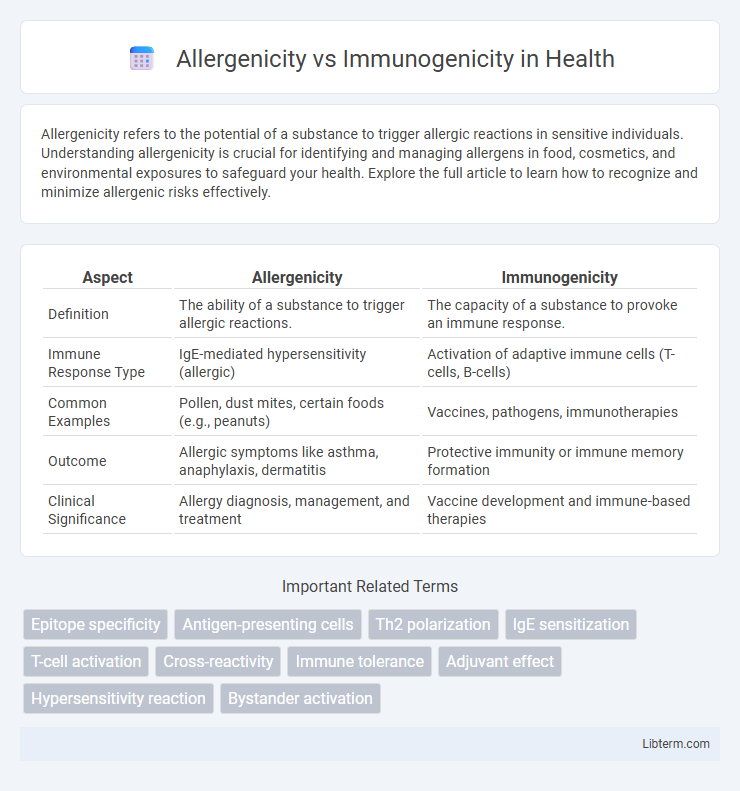Allergenicity refers to the potential of a substance to trigger allergic reactions in sensitive individuals. Understanding allergenicity is crucial for identifying and managing allergens in food, cosmetics, and environmental exposures to safeguard your health. Explore the full article to learn how to recognize and minimize allergenic risks effectively.
Table of Comparison
| Aspect | Allergenicity | Immunogenicity |
|---|---|---|
| Definition | The ability of a substance to trigger allergic reactions. | The capacity of a substance to provoke an immune response. |
| Immune Response Type | IgE-mediated hypersensitivity (allergic) | Activation of adaptive immune cells (T-cells, B-cells) |
| Common Examples | Pollen, dust mites, certain foods (e.g., peanuts) | Vaccines, pathogens, immunotherapies |
| Outcome | Allergic symptoms like asthma, anaphylaxis, dermatitis | Protective immunity or immune memory formation |
| Clinical Significance | Allergy diagnosis, management, and treatment | Vaccine development and immune-based therapies |
Understanding Allergenicity: Definition and Key Concepts
Allergenicity refers to the ability of a substance, known as an allergen, to provoke an allergic reaction by triggering an immune hypersensitivity response, primarily involving IgE antibodies. Key concepts include the identification of common allergens such as pollen, food proteins, and insect venom, and the mechanisms by which these allergens activate mast cells and basophils to release histamine and other mediators. Understanding allergenicity is critical for developing accurate diagnostic tests and effective immunotherapies in allergic disease management.
What is Immunogenicity? Fundamental Insights
Immunogenicity refers to the ability of a substance, such as an antigen, to provoke an immune response by activating specific immune cells and generating antibodies or cell-mediated immunity. This fundamental property underpins vaccine development and immunotherapy by ensuring that the immune system recognizes and responds effectively to pathogens or altered self-antigens. Understanding immunogenicity involves analyzing antigen structure, host immune status, and factors influencing antigen presentation and immune cell activation.
Allergenicity vs Immunogenicity: Core Differences
Allergenicity refers to the potential of a substance to trigger allergic reactions by activating hypersensitive immune responses, while immunogenicity denotes the ability of an antigen to provoke a specific immune response, including the production of antibodies. Core differences lie in allergenicity causing undesired hypersensitivity, whereas immunogenicity is essential for protective immunity and vaccine effectiveness. Understanding these distinctions is critical for vaccine development, allergy diagnostics, and therapeutic interventions targeting immune system modulation.
Mechanisms Triggering Allergenic Responses
Allergenicity involves hypersensitive immune reactions primarily driven by IgE antibodies binding to allergens, leading to mast cell degranulation and histamine release. Immunogenicity refers to the broader capacity of a substance to elicit an immune response, including activation of T cells and production of various antibodies. The mechanisms triggering allergenic responses include epitope recognition by allergen-specific IgE, cross-linking of FceRI receptors on mast cells and basophils, and subsequent release of pro-inflammatory mediators causing allergic symptoms.
Pathways of Immunogenicity Activation
Pathways of immunogenicity activation involve antigen processing and presentation by dendritic cells through Major Histocompatibility Complex (MHC) molecules to naive T cells, triggering adaptive immune responses. In contrast to allergenicity, which specifically induces IgE-mediated hypersensitivity, immunogenicity encompasses broader activation of B cells, T helper cells, and cytotoxic T lymphocytes via the interaction of antigen receptors with epitopes. Pattern recognition receptors (PRRs) on innate immune cells recognize pathogen-associated molecular patterns (PAMPs), initiating signaling cascades that enhance co-stimulatory molecule expression, cytokine release, and subsequent T cell activation, key steps in immunogenic response pathways.
Factors Influencing Allergenicity in Proteins
Factors influencing allergenicity in proteins include their structural stability, protease resistance, and glycosylation patterns, which affect immune system recognition and response. Protein size, epitope accessibility, and abundance during exposure also play critical roles in determining allergenic potential. Environmental influences such as pH, temperature, and food matrix interactions can modulate the allergenicity of proteins by altering their conformation and digestibility.
Determinants of Immunogenic Potential in Therapeutics
Determinants of immunogenic potential in therapeutics include protein structure, sequence variation, and post-translational modifications that influence recognition by the immune system. Factors such as epitope density, HLA binding affinity, and aggregation propensity critically affect the likelihood of immune response activation. Understanding these molecular and immunological parameters enhances prediction and mitigation of adverse immunogenicity in biopharmaceutical development.
Clinical Implications of Allergenicity
Allergenicity refers to a substance's capacity to provoke allergic reactions by triggering IgE-mediated hypersensitivity, while immunogenicity denotes the ability to elicit a broader immune response including antibody and T-cell activation. Clinically, high allergenicity demands careful evaluation during drug development and food safety assessments to prevent adverse allergic events, especially in at-risk populations. Understanding allergenicity enables improved diagnostics, personalized therapies, and safer formulation of biopharmaceuticals with minimized risk of anaphylaxis or hypersensitivity reactions.
Immunogenicity and its Impact on Drug Development
Immunogenicity refers to the ability of a substance, such as a drug or biologic, to provoke an immune response in the body, which can significantly impact its safety and efficacy during drug development. High immunogenicity can lead to the production of anti-drug antibodies, reduced therapeutic effectiveness, and adverse reactions, posing challenges in clinical trial outcomes and regulatory approval. Understanding and mitigating immunogenicity is essential for optimizing drug design, improving patient safety, and enhancing the overall success of biologic therapeutics in the pharmaceutical industry.
Strategies to Minimize Allergenicity and Immunogenicity
Strategies to minimize allergenicity and immunogenicity focus on modifying protein structures to reduce immune system recognition, such as site-directed mutagenesis and epitope mapping to identify and alter allergenic or immunogenic regions. Employing advanced bioinformatics tools enables precise prediction and design of protein variants with diminished immune responses while preserving therapeutic efficacy. Additionally, formulation approaches like PEGylation and encapsulation can mask antigenic sites, thus further decreasing the likelihood of adverse immune reactions.
Allergenicity Infographic

 libterm.com
libterm.com